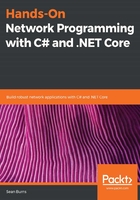
Networks in a Nutshell
It's hard to imagine that anyone reading this book doesn't have some intuitive idea of what a network actually is. As I write this introduction, I'm surrounded by no fewer than six distinct, network-connected devices within arm's reach. Even before I began a career in software engineering, I could have given a reasonably accurate description of what constitutes a network. However, no amount of intuition about what networks are or what might run on them, nor the use of software running on distributed systems, can account for the impact of a distributed architecture on your code. It's that impact on your software design and implementation decisions that we'll cover in this chapter.
We'll try to nail down a concrete definition of a network, and we'll consider the new problems you'll need to solve when writing software for them. This book assumes a fair amount of general programming skills within the C# language from its readers. I won't take any time to explain the use of native language structures, types, or keywords, nor will I discuss or explain the common general algorithms used throughout. However, I will stop short of making any assumptions of the reader's knowledge of networks, inter-device communication, or how those problems are solved in .NET Core. As such, this chapter will start from the most basic first principles and seek to provide a stable foundation from which anyone with at least some programming skill can proceed competently through the rest of the book.
The following topics will be covered in this chapter:
- The unique challenges of distributing computational or data resources over a network, and how those challenges manifest in software
- The different components of a network, and how those components can be arranged to achieve different goals
- The impact of the variability of devices, latency, instability, and standardization of networks on the complexity of applications written for network use
- Common concepts, terms, and data structures used for network programming, and how those concepts are exposed by .NET Core
- Understanding the scope of applications that are made possible by networked architectures, and the importance of developing skills in network programming to enable those kinds of applications